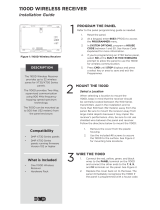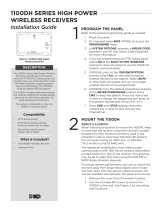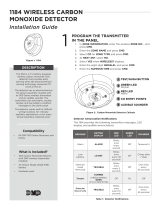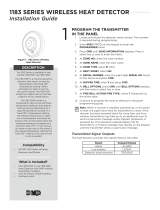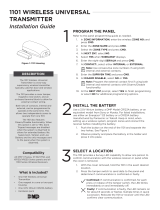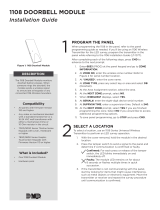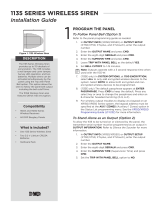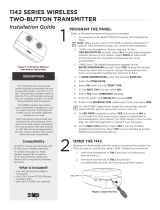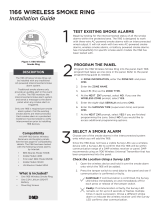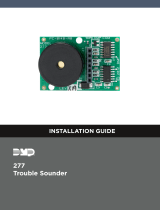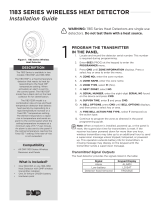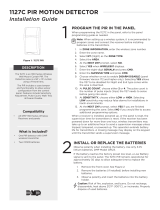La page est en cours de chargement...

1100DI IN-LINE WIRELESS
RECEIVER
Installation Guide
DESCRIPTION
Figure1: 1100DI Wireless Receiver
The 1100DI provides two‑way,
supervised communication using
900MHz frequency hopping
spread spectrum technology. The
1100DI In‑Line Wireless Receiver
provides up to 32 wireless zones
for XT30/XT50 Series Version 102
or higher. The compact design
allows the receiver to be installed
anywhere along the panel keypad
bus, such as next to a keypad. The
wireless system is designed so only
one 1100 receiver is used per panel.
Compatibility
• XT30 Series panels
• XT50 Series panels with firmware
Version 102 or higher
What is Included?
• One Model 1100DI Wireless
Receiver with housing
• One 4‑wire harness
• Hardware pack
1
PROGRAM THE PANEL
Refer to the panel programming guide as needed. After completing
each of the following steps, press CMD to advance to the next
prompt.
1. Reset the panel and enter 6653 (PROG) to access the
Programmer menu.
2. At SYSTEM OPTIONS, program a HOUSE CODE between
1 and 50. After turning on the house code, an XT50 will
display RECEIVER NO YES. Select NO. XT30 Series panels
can only work with external receivers. For more information,
refer to House Code Explained.
3. At ZONE INFORMATION, enter the wireless ZONE NO.
4. At *UNUSED*, enter the zone name.
5. At ZONE TYPE, press any select key or area and select the
zone type.
6. At NEXT ZN? select NO.
7. When WIRELESS? displays, select YES.
8. Enter the eight‑digit SERIAL# and press CMD.
9. Enter the SUPRVSN TIME and press CMD. Default is 240.
10. At the NEXT ZN? prompt, select YES to finish programming
or select NO for additional programming options.
2
WIRE AND MOUNT THE 1100DI
Select a Location
When selecting a location to mount the 1100DI, keep in mind that
the receiver should be centrally located between the 1100Series
transmitters used in the installation.
The 1100DI can be mounted up to 500ft (150m) from the panel
using 22AWG or 1000ft (300m) using 18AWG. Be sure to mount
the 1100DI away from large metal objects because it may impair
the receiver’s performance. Do not use shielded wire between the
panel and receiver.
Wire and Mount the 1100DI
Refer to Figure2 when mounting and wiring the receiver.
1. Remove the cover from the plastic housing.
2. Connect one end of the wire harness to the 1100DI bus
terminal. Connect the other end to the panel Keypad Bus.
3. Use the included screw to secure the 1100DI to the wall.
4. Snap the cover back in place.

2 1100DI INSTALLATION GUIDE | DIGITAL MONITORING PRODUCTS
ADDITIONAL INFORMATION
Transmitter Survey LED Operation
The 1100DIprovides survey LED capability that allows one person to confirm communication with the panel while the
cover is removed.
1. With the cover removed, hold the receiver in the desired location.
2. Press the tamper button to send a signal to the panel and determine if communication is confirmed or faulty.
Confirmed: For each press or release of the doorbell button the receiver LED blinks immediately on and
immediately o.
Faulty: If communication is faulty, the receiver LED remains on for about 8seconds or flashes multiple times
in quick succession.
3. If the receiver is not communicating with the panel, start by confirming that it is correctly wired and programmed,
then look for items that might cause interference such as large metal objects or electronic equipment. Relocate
the receiver until the LED confirms clear communication.
House Code Explained
The house code identifies the panel, receiver, and transmitters to each other. The 1100DI automatically sends the
specified house code to wireless transmitters when transmitter serial numbers are programmed into the panel. The
receiver only listens for transmissions using the specified house code or the programmed transmitters’ serial numbers.
Figure2: 1100DI PCB and Mounting Holes
Bus Header
Mounting Hole
Wire Opening

1100DI INSTALLATION GUIDE | DIGITAL MONITORING PRODUCTS 3
Transmitter Supervision Time
For UL Listed installations, program the transmitter supervision time in panel zone programming as listed in the following
table. Refer to the panel programming guide for complete wireless programming information.
UL Listing Listed Accessories Supervision Time
UL 268 Smoke‑Automatic Fire Detectors
1100R Repeater
1164 Wireless Synchronized Smoke Detector
3
UL 365 Police Station Connected Burglar Accessory
1100R Repeater
1103 Universal Transmitter
60
UL 521 Heat Detectors for Fire Protective Signaling
Systems
1100R Repeater
1183‑135F, 1183‑1353R Heat Detector
3
UL 609 Local Burglar Alarm Units and System Accessory
1100R Repeater
1103 Universal Transmitter
60
UL 634 Connections and Switches for use with Burglar
Alarm Systems Accessory
1100R Repeater
1101, 1102, 1103, 1106 Universal Transmitters
60
UL 636 Holdup Alarm Units and Systems Accessory 1142 Two‑Button Holdup Transmitter 60
UL 639 Intrusion Detection Units Accessory
1100R Repeater
1127W, 1127C PIR Motion Detectors
60
UL 864 Fire Protective Signaling Systems
1100R Repeater
1103 Universal Transmitter
3
UL 985 Household Fire Warning System Accessory
1100R Repeater
1135 Wireless Sounder
9060, 9063 Wireless Keypads
240
UL 1023 Household Burglary System Units Accessory
1100R Repeater
1101, 1102, 1103, 1106 Universal Transmitters
1127W, 1127C PIR Motion Detectors
1135 Wireless Sounder
1142 Two‑Button Holdup Transmitter
9060, 9063 Wireless Keypads
9862 Wireless Graphic Touchscreen Keypad
60
UL 1076 Proprietary Burglar Alarm Units Accessory
1100R Repeater
1103 Universal Transmitter
9862 Wireless Graphic Touchscreen Keypad
60
UL 1610 Central Station Burglar Alarm Units Accessory
1100R Repeater
1103 Universal Transmitter
1135 Wireless Sounder
9060, 9063 Wireless Keypads
9862 Wireless Graphic Touchscreen Keypad
60
UL 2075 Gas and Vapor Detectors and Sensors 1184 Wireless Carbon Monoxide Detector 240
Table1: Wireless Transmitter Supervision Times

Designed, engineered, and
manufactured in Springfield, MO
using U.S. and global components.
LT-0962 1.07 19354
1100DI IN-LINE
WIRELESS RECEIVER
Specifications
Operating Voltage to VDC
Current Draw mA
RF Power Rating mW
Frequency Range -MHz
Dimensions
Receiver Case ” L x ” W x ” H
Color White
Housing Material Flame retardant ABS
Patents
U S Patent No
Certifications
California State Fire Marshal (CSFM)
FCC Part Registration ID CCKPC0111
Industry Canada Registration ID 5251A-PC0111
ANSIUL Police Station Connected Burglar
ANSIUL Local Burglar Alarm Units and Systems
ANSIUL Connections and Switches for use with
Burglar Alarm Systems Accessory
ANSIUL Intrusion Detection Units Accessory
ANSIUL Household Burglar Alarm System Units
ANSIUL Proprietary Burglar Alarm Units
ANSIUL Central Station Burglar Alarm Units
ANSIUL Household Fire Warning System
INTRUSION • FIRE • ACCESS • NETWORKS
2500 North Partnership Boulevard
Springfield, Missouri 65803-8877
800.641.4282 | DMP.com
FCC INFORMATION
This device complies with Part 15of the FCC Rules. Operation is subject to the following two conditions:
1. This device may not cause harmful interference, and
2. This device must accept any interference received, including interference that may cause undesired operation.
The antenna used for this transmitter must be installed to provide a separation distance of at least 20cm (7.874in.) from
all persons. It must not be located or operated in conjunction with any other antenna or transmitter.
Changes or modifications made by the user and not expressly approved by the party responsible for compliance could
void the user’s authority to operate the equipment.
Note: This equipment has been tested and found to comply with the limits for a Class B digital device, pursuant to
part 15of the FCC Rules. These limits are designed to provide reasonable protection against harmful interference in
a residential installation. This equipment generates, uses and can radiate radio frequency energy and, if not installed
and used in accordance with the instructions, may cause harmful interference to radio communications. However,
there is no guarantee that interference will not occur in a particular installation. If this equipment does cause
harmful interference to radio or television reception, which can be determined by turning the equipment o and on,
the user is encouraged to try to correct the interference by one or more of the following measures:
1. Reorient or relocate the receiving antenna.
2. Increase the separation between the equipment and receiver.
3. Connect the equipment into an outlet on a circuit dierent from that to which the receiver is connected.
4. Consult the dealer or an experienced radio/TV technician for help.
INDUSTRY CANADA INFORMATION
This device complies with Industry Canada License‑exempt RSS standard(s). Operation is subject to the following two
conditions:
1. This device may not cause interference, and
2. This device must accept any interference, including interference that may cause undesired operation of the device.
This system has been evaluated for RF Exposure per RSS‑102and is in compliance with the limits specified by Health
Canada Safety Code 6. The system must be installed at a minimum separation distance from the antenna to a general
bystander of 7.87inches (20cm) to maintain compliance with the General Population limits.
Le présent appareil est conforme aux CNR d’Industrie Canada applicables aux appareils radio exempts de licence.
L’exploitation est autorisée aux deux conditions suivantes:
1. l’appareil ne doit pas produire de brouillage, et
2. l’utilisateur de l’appareil doit accepter tout brouillage radioélectrique subi, même si le brouillage est susceptible
d’en compromettre le fonctionnement.
L’exposition aux radiofréquences de ce système a été évaluée selon la norme RSS‑102et est jugée conforme aux limites
établies par le Code de sécurité 6de Santé Canada. Le système doit être installé à une distance minimale de 7.87pouces
(20cm) séparant l’antenne d’une personne présente en conformité avec les limites permises d’exposition du grand
public.
1/4
